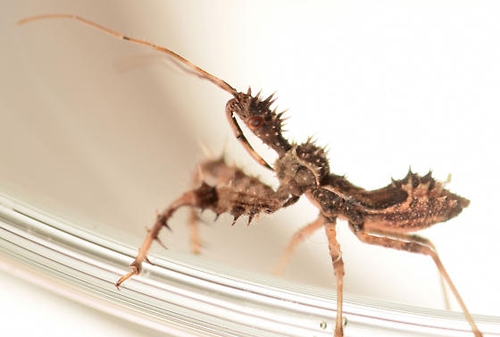
UC ANR Blogs
Got Moles?
A line of pushed up grass. A volcano sized mound. Yep, it's probably a mole! While you may never...
2025 UC Davis Biodiversity Museum Day Set Saturday, Feb. 8
Mark your calendar! The 14th annual UC Davis Biodiversity Museum Day is set for Saturday, Feb. 8,...

UC Davis professor Jason Bond, director of the Bohart Museum, shows butterfly specimens to Woodland residents Olive Smith, 8, and her mother Sarah Smith. Bond is the Evert and Marion Schlinger Endowed Chair, UC Davis Department of Entomology and Nematology, and associate dean, UC Davis College of Agricultural and Environmental Sciences. (Photo by Kathy Keatley Garvey)

The nematology display, headed by associate professor Shahid Siddique, was a popular attraction at the 13th annual Biodiversity Museum Day, held Feb. 20, 2024. From left are doctoral student Nick Latina and doctoral candidates Pallavi Shakya an Alison Blundell. (Photo by Kathy Keatley Garvey)
Spotted Lanternfly: The Need to Remain Vigilant (Part 1)
On March 27th, 2024, a flatbed truck carrying a metal art structure originating in New York and...
From Butterfly Research to High-Sugar Diet Research
What does butterfly metamorphosis have to do with high-sugar diet research? Well, you never know...

UC Davis distinguished professor Bruce Hammock (seated) with Jun-Yan Liu, professor at Chongqing Medical University, China, and a former research scientist (7.5 years) in the Hammock lab.

This 2010 image of Jun-Yan Liu shows him as a postdoctoral fellow working in the Bruce Hammock lab. He is now a professor at Chongqing Medical University, China. (Photo by Kathy Keatley Garvey)

This archived image (2018) shows UC Davis distinguished professor Bruce Hammock (seated) with Hammock lab researcher Sung Hee Hwang (center) and former Hammock lab researcher Guodong Zhang, now on the UC Davis Department of Nutrition faculty. (Photo by Kathy Keatley Garvey)
Introducing the Spiny Assassin Bug
Close readers of this blog will know that last year Mark noted toward the end of the season a very unusual looking insect in two of his strawberry research plots, which UCCE Entomologist on the Central Coast at the time Kirsten Pearson identified as the “spiny assassin bug”, an insect in the family Reduviidae of the order Hemiptera which includes insects very familiar to us like lygus bugs, minute pirate bugs, damsel bugs and big-eyed bugs.
These are not a common insect to find, and according to the literature are mostly found in meadows and weedy fields. At the time, Kirsten pointed out that these bugs being so few in number and generalist predators, meaning in strawberry along with lygus bugs they likely prey on all the above-named insects as well as ants and spiders.
Prey are killed by injection of saliva through their three segmented proboscis, and subsequently the internal organs of the prey is digested “pre-orally” so that the assassin bug can ingest it. This is fairly similar to the digestion method of lygus bug, which consumes plant matter much in the same way.
We can share a little bit about the biology of the assassin bugs. The eggs are deposited singly or in groups and are possibly covered by a glutenous substance by the female. Our reading of the literature indicates that there are not many eggs laid per individual bug, and there is only one generation of them in a single year.
On the whole, while an interesting and fierce looking predator in strawberry, given the information we have here, it seems doubtful given their low numbers that these assassin bugs could become a beneficial of much consequence in a program of prey management in strawberry. However, it is worth emphasizing as Kirsten did when we first starting finding them, that their presence does imply a level of healthy biodiversity in the field.

Fifth instar of spiny assassin bug - this looks a lot like what we have been finding in strawberry fields, especially towards the end of the season.
